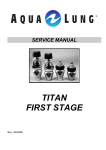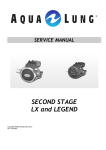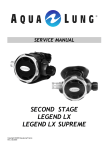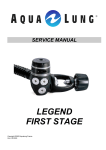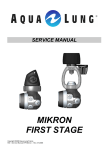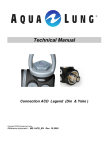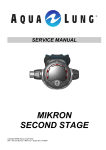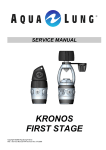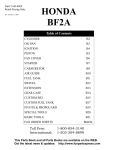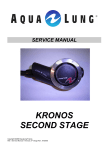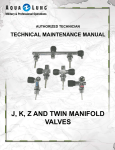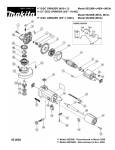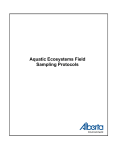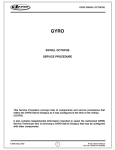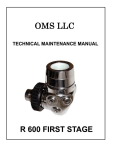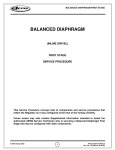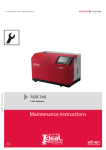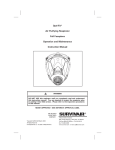Download Octopus ABS - scubaspares
Transcript
FIRST TO DIVE SERVICE MANUAL Octopus ABS Copyright ©11- 2004 Aqualung France Rev. 1/2004 2 Service manual Octopus ABS Index COPYRIGHT............................................................................................................................... 3 INTRODUCTION........................................................................................................................ 3 WARNINGS, ATTENTION, NOTE...……………........................................................................ 3 MAINTENANCE.......................................................................................................................... 3 GENERAL INSTRUCTIONS.....................……........................................................................... 3 GENERAL CONVENTIONS….................................................................................................... 4 DISASSEMBLY PROCEDURE…................................................................................................4 REASSEMBLY PROCEDURE......…...........................................................................................6 FINAL ASSEMBLY.....................................................….................................................….........7 Table 1. Troubleshooting guide................................................…............................…................9 Table 2. List of tools..........................................………........................…….....…………………..10 Table 3. Recommended cleaners and lubricants...............................................................…..... 11 Procedure A. Cleaning and lubricating........................................................................................12 Table 4. Torque settings..........................................................................................………........ 13 Table 5. Checking specifications..............................................................................……............13 Exploded view........................……………………………..............................................................15 F I R S T T O 3 D I V E COPYRIGHT This manual is the property of Aqualung France. Any copying, photocopying, reproduction, translation, electronic distribution (email, Internet...), even partial, and in whatever format, is expressly forbidden without the written consent of Aqualung France. GENERAL INSTRUCTIONS 1. In order to carry out the procedures described in this manual correctly it is important that you follow the steps in the exact order indicated. Read the manual through completely so that you become familiar with all the procedures, the special tools and the replacement parts, before starting to disassemble the product. Keep this manual open near to you so that you can refer to it step by step. Do not rely on your memory.. 2. All servicing and repair procedures should be carried out in a workshop that is clean, well lit, easy to access and specially fitted for the purpose. 3. The regulator body should never be directly held in the jaws of a vice. To hold the body, screw the tool 006230 into the HP port and then grip the tool with the vice. 4. Once the regulator has been disassembled, the reusable components should be separated from the components that need to be replaced. Fragile items with seats or crowns with critical sealing surfaces should be separated and protected during servicing in order to prevent any damage. 5. Use only spare parts from Aqualung service kits. Never replace an Aqualung part with one from another manufacturer, even if it appears similar. 6. Never re-use regulator parts which should be replaced on the pretext that the regulator has seen little use since its manufacture or since its last service. 7. When reassembling, check that the torque used conforms with that shown in Table 4, Torque. Some parts can be irretrievably damaged if the acceptable torque is exceeded. ©2004 Aqua Lung France. INTRODUCTION This manual gives the instructions and the recommendations for the disassembly, the cleaning, the checking, the reassembly and the adjustment of an Aqualung regulator. This manual is not an instruction manual for unqualified personnel. The procedures described in this manual are intended only for qualified personnel who have been trained in the servicing of Aqualung equipment during a specialised course. If you do not understand certain procedures in this manual you should contact an Aqualung service consultant before undertaking any operation. WARNINGS, ATTENTION, NOTES Certain icons have been used to facilitate the reading and understanding of this manual. They have the following meanings : . WARNING: Indicates situations that could result in serious or fatal accidents if the advice given is not followed correctly. . ATTENTION: Indicates a situation or action that could cause serious damage to the product, making it dangerous if the advice given is not followed correctly. NOTE : Notes are used to emphasize important points as well as information which needs to be remembered. MAINTENANCE Attention: Whatever the number of dives carried out during a year, the regulator should receive a complete service each year. If the regulator is used in a chlorinated or aggressive environment the service period should be reduced to six months. In order to conform with the Aqualung Regulator Lifetime Guarantee, all servicing (inspection, servicing and repairs) should be recorded in the Service Record incorporated in the regulator User Manual. GENERAL CONVENTIONS The conventions described below define the actions to be carried out when an instruction is given. 1. Unscrew: to unscrew a threaded part, turn it anticlockwise. 2. Screw: to screw a threaded part, turn it clockwise. 3. Remove the O-ring: To remove an O-ring follow the method below, using the special tool provided for this purpose. Any tool that could damage the O-ring should be avoided. In every case, replace the O-ring removed with a new one. Press simultaneously on the two sides of the O-ring in order to form an ‘eye’. . Insert the special tool into this eye to remove the O-ring. 4 4. 5. Service manual Octopus ABS The acronyms used: LP: Low Pressure MP: Medium Pressure HP: High Pressure Numbers in brackets indicate the part number of the component shown on the exploded view attached. 1. Block the crown holder (12) using a 19mm spanner and unscrew the hose with a 11/16" spanner. Remove the hose and then remove its O-rings 2. Cut the collar (23) using wire snips and remove the mouthpiece (22) from the casing (19). Check that the mouthpiece has no holes or defects. DISASSEMBLY PROCEDURE Note: Before commencing disassembly, consult the exploded view to check the reference numbers of all parts requiring replacement. These parts should all be replaced by new parts and should not be re-used on the pretext that the regulator has seen little use since its manufacture or since its last service. Attention: Use only the special tool when removing O-rings in order to avoid damaging the seal recess. The slightest scratch on a sealing surface could cause a leak. If a surface should be damaged then this part should be replaced with a new one. Do not use any pointed instrument or metal tool to remove O-rings. 3. Hold the casing (19) firmly and unscrew the ring cover (14) using tool 129198. 4. Remove the purge button (15), check that it has no cuts or defects. 5. Use tool 129198 (or A00188) to unscrew the diaphragm screw (15) F I R S T T O 5 D I V E 6. Hold the casing (19) down firmly and unscrew the crown holder (12) with a 19mm spanner. Remove the O-ring (11) from the crown holder (12) 12. Check the condition of the lever (3), it should not be deformed or corroded 7. Using a screwdriver, unscrew the seat (21) 6 or 7 turns Note: As the crown is fitted with an O-ring it may not fall out of the crown holder. It can be extracted using the tool 116236, to avoid damaging the sealing surface. 8. Insert tool 116236 into the insert, on the side opposite the hose, push the crown out. Remove the O-ring (20) 13. Check the condition of the spring (6), it should not be deformed or corroded 14. Using the O-ring tool, prick the centre of the seat (8) and extract the seat from the poppet (7). Keep the seat as it can be useful during reassembly. NOTE: The old HP seat can be useful during the reassembly of the Octopus. Put it aside for this purpose. 15. Place the handle of tool 116236 directly against the square poppet holder (5) and press until the poppet holder falls out. 9. Examine the crown with a magnifying glass to check that its sealing surfaces are all in good condition. 10. Push the insert assembly (4) into the casing inserting the index into the bump on the casing. Remove the insert assembly (4) by holding the lever (3). 11. To separate this assembly, screw the crown holder (12) into the insert (4). Using a 6.35 mm spanner, unscrew the Nylstop screw (1). Remove the washer (2) and the lever (3) from the insert. Unscrew the crown holder (12) to allow the poppet (7) and the spring (6) to be removed. 16. To remove the two exhaust valves you should first remove the grid (10). Insert the blade of a small screwdriver into one of the two slits in the casing (19) and push the screwdriver in until the grid clip is released. Repeat the operation for the second clip. 6 Service manual Octopus ABS 2. Fit the O-ring (20) onto the seat (21). Insert the crown into the crown holder (threaded part first) from the hose connection side. Push the seat home using the handle of tool 116236. END OF DISASSEMBLY Before starting to re-assemble the Octopus, make sure that all replacement parts have been cleaned and lubricated in accordance with Procedure A : Cleaning and Lubricating on page 13. 3. Use a screwdriver to screw the seat (21) into the crown holder. Screw it in completely and then unscrew it two and a half turns. 4. Place the crown holder upright on a flat surface, the seat’s sealing surface uppermost. Fit the O-ring (11) in the groove at the base of the threaded part. 5. Place the old seat removed during disassembly onto the sealing surface. RE-ASSEMBLY PROCEDURE NOTE: Before starting reassembly, it is important to check all the parts. All old and new parts should be perfectly clean and free of any dust or rust. 1. Fit the two exhalation valves (9), pass the valve tail through the hole in the casing from the outside and pull gently until the notch is inside the casing. If it is a new valve cut off any excess tail leaving about 5mm. Repeat for the second valve. Engage the two upper grid clips (10) in the two upper slits in the casing. Engage the two lower clips and press on the bottom of the grid next to the two clips. 6. Fit the square poppet holder (5) onto the rod of the tool 116236, square side upwards. Engage the tool into the insert (4) and across the centre square. Align the square section of the holder with the square recess in the insert and push with the tool to engage the holder into the insert. After assembly the square holder should be at the same level as the insert. F I R S T T O 7 D I V E 7. Fit the seat (8) into the seat holder (7). 8. Fit the spring (6) onto the tail of the seat holder (7) 9. Insert the poppet and its spring into the seat holder and screw in the insert (4) to compress the spring. Continue to screw in until the threaded part of the poppet emerges from the insert. Attention: If resistance is felt while screwing in, step and unscrew a little to ensure that the square sections of the crown holder and the poppet holder are aligned. 10. Position the insert assembly and turn it so that the injection hole is at 8 o’clock. Put the lever into the groove on the insert, with the rounded part of the lever uppermost. 11. Place the washer (2) onto the tail of the poppet, then the Nylstop screw with its flat side downwards. Screw the Nylstop in by hand to engage the thread, then continue using a 6.35mm spanner until the first thread appears. 12. Hold the insert and the lever and unscrew the crown holder (12). Check that the lever feet have not come out of the groove. Remove the old seat (8). 13. After removing the old seat (8) screw the crown holder (12) back in to the insert (4) Tighten the crown holder by hand. NOTE: The preliminary reassembly of the Octopus ABS is now complete. Do not continue reassembly until you have adjusted the insert assembly using the following procedure. Attention: Bad adjustment of the Nylstop screw can overload the screw in the Octopus, which could degrade performance. 1. Screw in the Nylstop using a 6.35mm hex spanner until a slight leak is heard. 2. Press lightly on the lever several times to induce airflow. 3. Unscrew the Nylstop ¼ turn. 4. Press lightly on the lever several times to induce airflow to check that there are no leaks. Attention: Overtightening the Nylstop can cause a slight withdrawal of the poppet from the seat. Do not correct this defect by screwing in the seat. 7. Turn off the air supply to the regulator, purge the circuit by pushing gently on the lever. Remove the adjustment tool. 8. Unscrew the seat from the insert while pressing on the lever. Final Assembly 1. Place the insert assembly into the casing with the lever pointing upwards. Introduce the insert assembly into its position in the casing until the threaded female part of the insert is just visible outside the casing. 2. While holding the lever down, manually screw the seat into the casing. While holding the lever down, use a 19mm torque wrench to screw in the seat at 1m.Kg. 8 Service manual Octopus ABS 3. Fit the diaphragm and the washer into the casing. 4. Screw in the diaphragm retainer (15) using the spanner 129198 (or A00188). 5. Fit the purge button into the casing and screw on the outer ring by hand or using tool 129198. 6. Refit the mouthpiece on the casing. Fit the collar strap into the groove on the mouthpiece. FINAL CHECKS 1. Connect the Octopus ABS to a first stage adjusted to 9.5 Bar(±0.5) 2. Put the regulator under pressure with a 200 bar (±10 bar) supply. Note: Tests 2,3 and 4 require the use of a Regulator Test bench. 3. Opening effort check. Apply an increasing inhalation flow. When the MP starts to fall, note the effort reading and compare it with the limits shown on Table 5. Checking specifications . If the opening effort is outside the limits then check Table 1. Troubleshooting Guide. 4. Flow/effort test . Apply an inhalation flow of 400 l/min and check that the effort does not exceed 15 mbar. If the effort exceeds this then check Table 1. Troubleshooting Guide. 5. Purge flow test. Connect the second stage to a flow meter and press on the purge button. The measured flow should be above or equal to 300 L/min. If it is below then check Table 1. Troubleshooting Guide. 6. Leak test. Connect the first stage to a cylinder charged to 200 bar, open the cylinder valve and immerse the set in a fresh water bath for one minute. Check that there are no leaks. If a leak is detected, disassemble the nd entire 2 stage; check all sealing surfaces and the correct positioning of all parts. 7. Breathing test. Press several times on the purge button. Put the regulator in your mouth and breathe deeply and slowly several times. A regulator in good condition should deliver air without excess effort throughout the inhalation and without vibration of the diaphragm. During exhalation the exhaust valves should not stick or vibrate. If any of these faults occur then check Table 1. Troubleshooting Guide. END OF REASSEMBLY Table 1. Troubleshooting Guide SYMPTOM Leak or free flow at 2nd stage Insufficient purge flow or work of breathing too high Reduced air flow or high breathing resistance from complete regulator POSSIBLE CAUSE TREATMENT 1. MP too high 1. Refer to First stage Troubleshooting Guide 2. The valve (8) is worn or damaged. 2. Replace the valve 3. The seat (21) is not correctly adjusted 3. Readjust the seat 4. The lever (3) is bent 4. Replace the lever 5. The sealing face of the seat (21) is damaged. 5. Replace the seat 6. The spring (6) is damaged 6. Replace the spring 1. MP too low 1. Refer to First stage Troubleshooting Guide 2. The valve (21) is not correctly adjusted, the lever adjustment is too low 2. Readjust the lever and the valve 3. MP hose obstructed 3. Clean or replace the hose 4. Le lever (8) is bent 4. Replace the lever 1. Hole in mouthpiece (17) 1. Replace the mouthpiece 2. Diaphragm (19) damaged 2. Replace the diaphragm 3. Exhalation valves (9) damaged 3. Replace the valves 5. The diaphragm is not correctly fitted between the casing (19) and the washer (17) 5. Disassemble the purge button and refit the assembly correctly 6. The casing is damaged. 6. Check the sealing face of the exhalation valve. Replace the casing 7. The O-ring (20) is damaged. 7. Replace the O-ring 8. The insert O-ring (11) is damaged. 8. Replace the O-ring 10 Service manual Octopus ABS Table 2. List of Tools DESCRIPTION APPLICATION US PART NO. MP pressure gauge complete 0/16B Checking medium pressure 111610 O-ring tool Fit / remove O-rings 944022 Seat fitting tool Seat assembly/disassembly 109436 N/C Torque wrench 1 m.kg Crown holder N/a N/C Medium flat screwdriver Adjusting seat N/a N/C 19mm Crown holder N/a N/C 11/16 » flat spanner Hose nut N/a Lug spanner Cover ring, diaphragm retainer N/a N/C Small flat screwdriver Grid N/a 116239 6.35mm hex spanner Nylstop nut N/a 128004 Second stage service kit REF 116222 N/C 116236 129198 Tools from service kit 116245 : Table 3. Recommended cleaners and lubricants LUBRICANT / CLEANER Christolube MCG 111 APPLICATION All O-rings SOURCE Aqualung, ref. 480025 Attention: Silicone parts do not require lubrication. Do not grease them. Greasing silicone parts can change their molecular construction and cause premature degradation of the material. Oakite #31 Acid bath for cleaning brass and stainless steel parts. Oakite Products, Inc. NETALU Acid bath for cleaning brass and stainless steel parts. Aqualung, ref. 455001 Diluted white vinegar Acid bath for cleaning brass and stainless steel parts. Household stores Attention: Do not use hydrochloric acid for cleaning parts. Hydrochloric acid, even when well diluted, attacks the coating of metal parts and leaves a corrosive deposit that damages plastic parts and O-rings. Washing-up liquid (diluted with hot water) Degreases brass and stainless steel parts; Household stores general cleaning of plastic and rubber parts. 12 Service manual Octopus ABS Procedure A Cleaning and Lubricating (All Aqualung Regulators) Cleaning brass and stainless steel parts. 1. 2. 3. Pre-clean by soaking in NETALU diluted to 25%. Cleaning in an ultra-sonic bath filled with a mixture of washing-up liquid + hot water. If some resistant deposits remain then fill the ultrasonic bath with white vinegar and repeat. DO NOT put plastic, rubber, silicone or anodised aluminium parts in contact with vinegar. Rinse in demineralised or fresh water to avoid calcium deposits. Soak for 10 minutes. Dry with filtered low pressure air and then check that their condition is now suitable for re-use. Cleaning plastic, rubber and anodised aluminium parts. For anodised aluminium parts : soak in a « NETALU diluted to 25% ». Rinse in fresh water and dry with low-pressure filtered air. For plastic parts. (casings, plugs..) : clean in an ultrasonic bath containing a mixture of washing-up liquid and hot water. Use only a toothbrush with nylon bristles to remove any deposits. Rinse in fresh water and dry with low pressure filtered air Attention: D not place plastic and rubber parts in contact with acid solutions. This could alter their physical properties and cause degradation and premature breakdown. Cleaning parts for Nitrox/O2 use. 1. 2. 3. 4. Metal parts : Pre-clean by soaking in NETALU diluted to 25%. Ultrasonic cleaning in Promoclean TP108 diluted at 5% . Rinse in demineralised water. Soak for 10 min. Dry in the open air in a clean and dust-free atmosphere. Place the parts on a white cloth, allow to dry and check after drying that the cloth shows no grease deposits and that the condition of the parts is appropriate for re-use with Nitrox/O2. Cleaning hoses. If there is significant corrosion then it is permissible to soak only the ends in an ultrasonic bath, avoiding any possibility of the solution entering the hose. Rinse in fresh water and allow to dry with the connections hanging down. Dry the inside with filtered compressed air before reconnecting the hose to the regulator. Wiping. To wipe parts, use a white filter paper, a pure cotton cloth or any other material that does not produce fluff. Inspection. Visually check under a white light (day light or artificial light). The parts are completely free of any traces of : 1. 2. 3. 4. organic materials (oil, grease, paint, rust…) cleaning agents dust humidity Lubrication. When handling O-rings wear unpowdered latex gloves. It is important not to allow contact between the internal components and the skin or any other source of contamination when the regulator is being prepared for Nitrox use. All seals should be lubricated with Cristolube MCG111. Cover the seals with a light film of grease and remove any excess by rolling the seal between finger and thumb. Do not use an excess of grease, this can have the effect of accumulating particles which could damage the O-rings. Table 4. Torque values N° REFERENCE DESCRIPTION COUPLE 124506 Crown holder 1 m.kg. Table 5. Checking specifications TEST INSTRUCTIONS SPECIFICATIONS Leak Test 160 bar < Working pressure < 200 bar No leak Medium Pressure 160 bar < Working pressure < 200 bar MP at 9.5 bar ± 0.5 bar : Opening effort 160 bar < Working pressure < 200 bar Effort / Flow MP at 9.5 bar ± 0.5 bar between 2 mbar and 5 mbar 15 mbar maxi at 400 L/min 14 Service manual Octopus ABS Maintenance Notes. Exploded view of octopus ABS second stage. 16 Service manual Octopus ABS FIRST TO DIVE 1ere Avenue – 14e rue – BP 148 06513 CARROS cedex – France 00 33.(0)4 92 08 28 88 FAX 00 33.(0)4 92 08 28 99 Rev. 11/2003
















